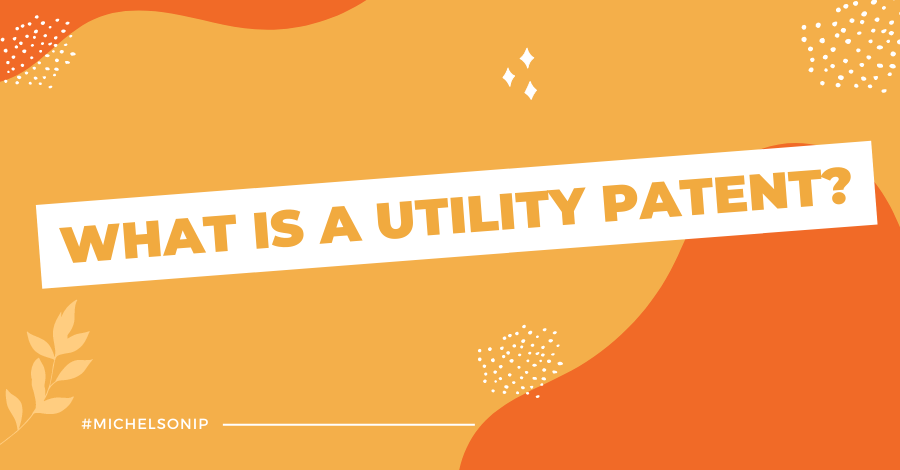What is a utility patent?
In the film “Romy and Michelle’s High School Reunion,” Mira Sorvino’s character claims to have invented the Post It. Her classmates are skeptical, but had she shown them a patent listing her as the inventor, they might have been impressed!
First, let’s define a patent. The United States Patent and Trademark Office (USPTO), defines it as follows:
“A patent for an invention is the grant of a property right to the inventor, issued by the United States Patent and Trademark Office.”
Types of patents
There are three types of patents:
- utility patents – according to the USPTO, are issued for anyone who “invents or discovers any new and useful process, machine, article of manufacture, or composition of matter, or any new and useful improvement thereof.”
- design patents – issued for those who invent an ornamental design for manufactured items
- plant patents – issued for inventions related to the discovery and reproduction of new varieties of plants
This article will focus on utility patents.
Components of a Utility Patent Filing
Filing for a utility patent can be complex, as there are a number of components required. These include:
- Utility Patent Application Transmittal Form or Transmittal Letter – This is a USPTO specific form which contains an overview and summary of the items being filed, who is filing, and general information about the invention. It is always on top of the patent application packet.
- Appropriate Fees – There are several required filing fees for a patent, and depending on various factors, there could be additional fees. Generally speaking, non-provisional utility patent applications will include:
- basic filing fee ($80-$320);
- patent search fee ($175-700);
- examination fee ($200-800);
- issue fee ($300-1200); It is recommended to file electronically, as paper filing incurs an additional cost.
- USPTO’s pro bono program can assist those under cost-prohibitive circumstances
- Application Data Sheet – This is a Federal regulation and contains bibliographical information on the inventor, as well as others involved in the invention. The inventor provides more specific information on both the “who” and “what” with regards to the invention.
- Specification – This is the meat of the actual invention. The inventor must describe the process of creation in a succinct and clear manner. This must be done in such a way so that someone who has experience in the area of the invention could use the specification to recreate it. The USPTO provides section headings as guidance to help provide clear information for this component.
- Drawings (when necessary) – Drawings show the detailed features of the invention. They aren’t a required component, but generally, most patents contain drawings, as it helps clarify the processes and subject matter being presented. Note that the USPTO has Drawing Requirements, which can be found here: https://www.uspto.gov/web/offices/pac/mpep/s1606.html.
- Executed Oath or Declaration – This is a signed declaration pertaining to the signer’s belief that he or she is the original inventor of the creation. As with most sections, there is additional information about this on the USPTO’s website.
- Nucleotide and Amino Acid Sequence Listing (when necessary) – This is exactly what it sounds like – a scientific sequence, which, if present in the creation of the patent, must be submitted with the application.
- Large Tables or Computer Listings (when necessary) – Another area that is exactly what it sounds like. The purpose of submitting all of this information is to provide the roadmap for someone to recreate the invention, so anything that is integral to the process must be provided.
All documents/elements must be in a specific order. A detailed filing guide can be found here.
Provisional vs Non-Provisional
The guidance above is focused on non-provisional patents, which is the “full” utility patent application granting a patent.
A provisional patent application (PPA) is a lower cost application with less stringent filing requirements. It can be considered a “placeholder” for the inventor, who may need additional time working on the invention.
A provisional patent lasts 12 months, and cannot be renewed. The inventor must generally file the nonprovisional patent application of the 12-month period expiration.
Historical Utility Patents to Know
It would be difficult to imagine the modern world without many of the patented inventions of the last 150 years. For example, Apple has thousands of utility patents for its products, including the famous Apple II computer, which lists Steve Wozniak as the inventor (Patent number 4136359).
Francis Jon Woods, an African American inventor from Greenville, Michigan was awarded a patent for improvements to the mechanical construction of the potato digger in 1895.
Thomas Edison received a patent for the light bulb on January 27, 1880. One of the drawings for this historic invention can be found here: https://www.archives.gov/historical-docs/edisons-light-bulb-patent (Patent number 223898)
And of course, Post-Its have been patented. Arthur Fry is listed as the inventor of “Repositionable pressure-sensitive adhesive sheet material.” (Patent number 5,194,299)
Further Reading
_________
 The Michelson Institute for Intellectual Property, an initiative of the Michelson 20MM Foundation, provides access to empowering IP education for budding inventors and entrepreneurs. Michelson 20MM was founded thanks to the generous support of renowned spinal surgeon Dr. Gary K. Michelson and Alya Michelson. To learn more, visit 20mm.org.
The Michelson Institute for Intellectual Property, an initiative of the Michelson 20MM Foundation, provides access to empowering IP education for budding inventors and entrepreneurs. Michelson 20MM was founded thanks to the generous support of renowned spinal surgeon Dr. Gary K. Michelson and Alya Michelson. To learn more, visit 20mm.org.
